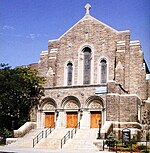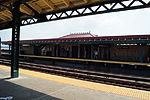Inwood, Manhattan
Dominican-American culture in New York (state)Harlem RiverInwood, ManhattanIrish-American culture in New York CityNeighborhoods in Manhattan ... and 3 more
New York (state) populated places on the Hudson RiverUse American English from April 2021Use mdy dates from January 2019

Inwood is a neighborhood in the New York City borough of Manhattan, at the northern tip of Manhattan Island, in the U.S. state of New York. It is bounded by the Hudson River to the west, Spuyten Duyvil Creek and Marble Hill to the north, the Harlem River to the east, and Washington Heights to the south. Inwood is part of Manhattan Community District 12, and its primary ZIP Code is 10034. It is served by the 34th Precinct of the New York City Police Department and Engine Company 95/Ladder Company 36 of the New York City Fire Department. Politically, it is part of the New York City Council's 10th district.
Excerpt from the Wikipedia article Inwood, Manhattan (License: CC BY-SA 3.0, Authors, Images).Inwood, Manhattan
Broadway, New York Manhattan
Geographical coordinates (GPS) Address Nearby Places Show on map
Geographical coordinates (GPS)
| Latitude | Longitude |
|---|---|
| N 40.867 ° | E -73.922 ° |
Address
Broadway 4900
10034 New York, Manhattan
New York, United States
Open on Google Maps








